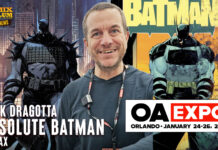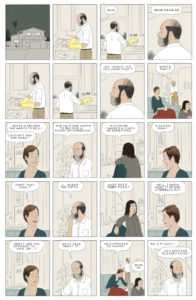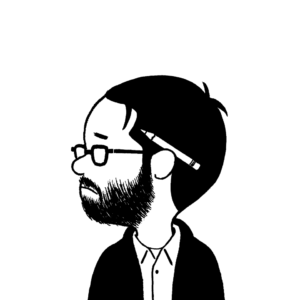OPTIC NERVE #14
Stories & Art by: Adrian Tomine
Publisher: Drawn + Quarterly
Cover Price: $6.95
This book can’t be any more off the beaten path for me. After espying that issues #1 and #8 were going to second printings a few months back on www.previewsworld.com, I was beyond intrigued. Once I began investigating, I discovered that this on-going series has existed for two decades published by the present company. Shock followed shock when I noticed that D+Q is Canadian, based in Montreal!!! As a fellow red-white-and-red citizen, I’m beaming and pleasantly surprised by this revelation.
The doors have been blown apart!! My awareness of this critically acclaimed series is off the chart!! The expansion of knowledge continues! I’ve always known of Drawn+Quarterly but never bothered to browse let alone purchase their eclectic, quality pieces. I’m glad I no longer live in a bubble occupied by the Big Two.
I will attempt to do justice to this brand spanking new œuvre d’art. Fans have been foaming at the mouth considering the previous issue was released almost two whole years ago, July 2013 to be precise.
“Killing and Dying” (22 pages)
Stand-up comedy is not a highly-lauded career choice. Nevertheless, 14-year-old Jesse wants to take a stab at this. Her mother is all enthusiastic and encouraging whereas her father is the complete opposite: wary and unsupportive. Daddy Dearest is blunter than any object intended for harm. He’s opposed to embarrassment. The question is: for himself or his daughter? Mom brushes it off and tells Jesse not to pay any mind. Upon researching a class titled ‘Junior Yucks’ with semi-impressive credentials, and the low cost of $500, the decision has been made.
When the two are alone, Dad muses over Jesse’s phases and their costs – ukulele and trapeze lessons. Those were obviously abandoned by his darling daughter. Mom retorts with this little tidbit: parenting is not about cost/benefit analysis. Dad accurately states that it’s about avoiding ridicule directed at Jesse. He underlines the most fundament role of parents: protecting their children. Mom agrees but believes Jesse should pursue this endeavour. Plus, she believes that hubby is more worried about his own rep.
The best way to start stand-up is to perform in front of family and friends. Here’s the astonishing twist and ultimate irony: Jesse stutters. Her speech impediment does not prevent her from fulfilling this dream. One more cruel thing to point out: she’s below rank amateur but Mom and Dad seem to be in stitches.
Well-renown and well-established comedians are discussed at the table: Ellen DeGeneres, Jerry Seinfeld, and Jeff Foxworthy whose name escapes Mom since she refers to him as “ ‘you might be a redneck’ guy”. Jesse wants to tackle off-colour humour, or as she calls it “works blue”. The effect will be more reaching since it is crude and vulgar. Dad encourages it. Mom vetoes it. Mom gives her precious a boost in self-esteem by telling her not to put herself down and to not debase others.
Opening night has arrived! Jessica is second after some poor schmuck named Ronald bombs. Various degrees of laughter are measured: polite, uproarious, explosive, scattered, thunderous, along with the obligatory applause. Parents couldn’t be any prouder. Afterwards, they approach Jesse. She snaps at them saying she would meet them outside. She is seen chatting with her coach/instructor/mentor Brayden. When Dad asked about the material delivered, Brayden admits that it wasn’t original but that Jesse had a hand in modifying it. Dad storms out, rightly pissed at forking over half a grand.
As the trio celebrate at the Cheesecake Factory (to die for!!), Mom poses the question: what is the main purpose of a comedian? Jesse is at a loss; Dad makes a snarky remark. Easiest answer in the book: to make people laugh. Mom praises Jesse. Dad makes a passing comment about copyright infringement. Jesse walks out. She and Mom are seen talking and hugging it out. How can an aspiring funny girl not know the true calling?!? Interesting, indeed!!
Some time has passed. Jesse has put on weight. Mom died. I didn’t immediately notice anything amiss. Therefore, I re-read the first half and saw the hair thinning out before the head scarf. How much time is irrelevant but Jesse has been at her gig for a while. Dad’s fears were unfounded. The relationship between Daddy-O and Love Child is still strained. Getting along is an awkward attempt. The next step for Jesse will be improv. After an explanation, Dad asks if there are any classes for that. Jesse assures him she can get her free education via the magic of YouTube. Geez!! Truer words have never been spoken. A night at the movies proves to be lacklustre.
Jesse wants to do an open mike at the Grind House. Dad is all systems go but Jesse wants to ride solo. She doesn’t want to be held back by her parental unit. After she’s gone, Dad utters FML (more or less) and stealthily sits in the crowd. Let the colour humour (pun intended!) begin!! First up, a young African-American who gripes about Caucasians being racists and wanting to spit out the ‘N-word’ even though they dare not.
Jesse’s jokes fall flat. She might as well give up the ghost but she carries on. Engaging the audience is an epic fail. She then resorts to insulting an older woman who told limericks, takes a pot shot at a spectator’s weight, proceeds to throw the race card, and embarrassingly and erroneously targets her predecessor: “wrong black dude!” Rejection is no bitter pill for her. The girl has gumption. Even after the Limerick Lady imitates Jesse’s stuttering, she is dumbfounded that her routine is over. Dad pulls a hasty retreat and utters aloud the F-word before Jesse gets home.
Dad releases his rage and grief. He grabs a portrait of his dearly departed spouse and blames her for their progeny’s unwise move. He is frustrated to the point that he bangs his head against the wall until he loses consciousness. Jesse finds him face-planted. Any indication of his presence is easily concealed. He asks her about the outcome. She gives the generic response of “pretty good”. He verbalizes his pride. She rubs the bump on his forehead. End of story.
Nag! Nag! Nag!
Just what was it that Jesse put into/took out of the toilet paper roll? A microphone? A pregnancy test? A tampon? Inquiring minds want to know!!!
The number one rule in telling a joke is to never explain the punch line. It ruins the delivery and undoes the entire thing. I’m not necessarily going to do that but I will point out the puns in the title. One can slay a group of people via laughter. The French say it best: MDR — mort de rire which literally translates as “dead/dying of/from laughing/laughter”. Us Anglos opt for LOL. At any rate, a most serious topic is sneakily inserted into this not-so-funny tale. Mom is a helicopter parent. This is reflective of a society where placing 17th in any competition grants you a major reward and copious amounts of praise. There’s a fine line between enabling and pointing out realistic goals. This is up for debate. Obliviousness can only get you so far. As I previously mentioned, I failed to observe Mom’s condition until after her death. If that was your intent, Mr. Tomine, you succeeded. Bravo! Not to pat myself on the back, but I’m glad I’m very thorough and always re-examine things.
I still find it hard to critique art. I have below zero talent in that field. Luckily, I also research before and after. All I can say is that Mr. Tomine has clean line work. I find the mostly twenty panels per page visually engaging. The more details that can be crammed, the better. The elongated panels provide more exposure. The white space indicates pause and/or transition as shown on pages 17 and 26. The characters are indicative of the typical middle-class American family. No exaggerated attractiveness, just plain, unassuming individuals trying to make a mark in the world.
“Intruders” (9 pages)
This story goes past the limit of creeper/stalker. The unnamed narrator is a down-on-his-luck has-been. Details are sketchy but he finds himself living the dullest life. His constant companion/girlfriend/life partner/wife Maria is long gone. He ekes out and extends his existence at the cheapest hotel: Stay America.
The not-so-distant past re-emerges when some young woman who house-sat for him and Maria spots him at what is presumably a greasy spoon. The place is so unimportant that even John Doe can’t recall the name. The interaction is significantly awkward: he tries to place her in his memory, she fishes out the keys that have long been forgotten, then Mr. Smooth bear hugs her in the parking lot to which she mentions a boyfriend. Yeah…Moving on.
The copied keys are chucked. The morning after, he feels a tinge of curiosity. Perhaps they can still allow access to his former residence. Sure enough, he’s home again!! What starts as inquisitiveness turns into an unhealthy, obsessive routine of ‘checking in’. Intentions are innocent enough but when OCD coupled with paranoia kick in, the habit is beyond impossible to break.
The snake in the grass eventually rears its head. After an undetermined amount of time, the loser is present when a break-in occurs. Some young punk. Mild mystery abounds: is this his place or does he want to burglarize? John Doe grabs him and proceeds to give him a pounding. Youth are resourceful. The pseudo-robber grabs a razor and slashes his face. The kid gets another beating and is allowed to leave. He does so firing an expletive at his attacker.
Things goes downhill from there. Trivial matters such as getting coffee from a bubble tea place are no longer a reality. The last time Mr. Unknown sets foot in his previous abode, he comes across an elderly woman sprawled on the floor. She addresses him in some foreign language and rightly freaks out. Help leads to hindrance. After he places a call to 911, he tosses what I assume is her phone, and throws what were once his keys into the gutter. He decides he must carve a new kind of niche from this point forward.
Once again, there’s a double-entendre with the title. This makes me smile widely. I relish in wordplay and pride myself as a punster. It’s a matter of perspective but who was the actual interloper?? Mr. Tomine approaches a serious topic in a refined manner. How low can one go to escape the hamster wheel? The new lease on life was ephemeral but it was of great importance to the anonymous man. The snag in his plans left him no choice but to re-examine, re-evaluate, and re-start.
The layout is standard all the way through: nine panels for each of the nine pages. Symmetry!! The narration is essential for the reader to glimpse the inner workings of Joe Blow’s mind. The dialogue is minimal as it should be since day-to-day communications aren’t always meaningful nor prolonged. Many times, scant words or sentences are sufficient. This also highlights the loneliness prevalent in the narrator’s life, the isolation he faces, and the alienation experienced at the bubble tea place or other public venues.
The sepia-infused squares emphasize the murkiness. This man’s life is not only drab but it’s a major drag. He is a speck of dust in an infinite tapestry. He’s neither here nor there in the comings-and-goings of Life’s commuters. He is not accomplished enough to stand out of the crowd. He is a salmon, swimming upstream with his run of fellow fish.
***NOTE: the scan for this entry is imperfect because I didn’t want to bend the spine of this gorgeously bound book.***
untitled (1 page)
In this deliberate autobiographical sketch, Mr. Adrian Tomine delivers a picture essay on achieving fame and wealth. The setting is Brooklyn, one year ago. Mr. Tomine is vehemently opposed to using social media to give his works a boost. His acquaintance is incredulous at his thinking.
Later, while taking to his publisher Oliveros (real-life Chris Oliveros, founder of Drawn+Quarterly), Mr. Tomine balks at the proposition of commercializing himself and his twenty-year accomplishments.
Shifting to the other side of the country, Mr. Tomine meets with a producer who wants to make a motion picture out of one of his critically-acclaimed cartoons. The L.A. exec is real curious about Mr. Tomine’s ‘numbers’. When Adrian admits that Facebook and Twitter are foreign to him because he embraces his nostalgic roots and bucks the trends, there is dead air.
Couch therapy leads to one foregone conclusion: he has control issues, mild OCD, blatant narcissism, fabricated pride and self-created superiority. All trappings of a comic book creator, I suppose. The shrink is none other than real-life spouse Sarah Brennan. After asking him to pick up their daughter Nora, she delivers one more blow to throw Adrian out of synch — the rent is about to be doubled and she is pregnant. The man just can’t catch a break!!
The simple black and white renditions in the tightly structured twenty panels make the strip serial in nature. Were this a daily read, one could easily catch up on the five installments. Interestingly enough, the most number of panels focus on Mr. Tomine’s principles despite the disbelief of his friend/colleague/acquaintance. An equal amount of time is given to the missed movie pitch and his home life. Fame is so fleeting that the deal is gone and most certainly forgotten before it even took flight. The hectic nature of young families is presented dead-on. Responsibilities never end. Chores must be done. Bills pile up.
If I had to give this story a name, I would choose “Sell-Out”.
***NOTE #2: the scan for this entry is also imperfect because I didn’t want to crack the spine of this magnificently put-together book.***
Letters
These are extremely humorous. I really wonder about their validity. Adrian has some international reach since the readers hail from Europe and Australia as well as various parts of the States. The fandom reaches outrageous levels. Be they fictitious or authentic, I snickered at all of them.
How invigorating to veer off course and peruse material completely out of my realm!!! This issue was so enjoyable that I hunger for more!! I’m going to have a hard time finding back copies. My education went up another notch in regards to this title, the master behind it, and the publisher that supports it.
Even more eyebrow-raising is the fact that Mr. Tomine finds network-buildings sites anathematic. There’s an official disclaimer on his own page: http://www.adrian-tomine.com/News.html Upholding his ideology in this manner is extremely admirable.
Here it is in full:
“Please Note
Adrian Tomine does not maintain a Facebook or Twitter account. Web pages that might suggest otherwise are the work of anonymous strangers. Please check this site, as well as www.drawnandquarterly.com, for any news pertaining to upcoming publications or events. Adrian can be contacted via Drawn & Quarterly, or care of the following address:
PO Box 94
Prince Station
New York, NY 10012
Apologies for any confusion, unacknowledged messages, etc.”
One more observation to make: the cover has a gold flap which gives way to detailed plans of a house. The architecture is accurate. The house is the standard size for a couple or small family. The back cover is pure gold with the obligatory information like the price, barcode, and websites. Ingenuity at its very best. The font is not fancy and the logo is Courier. The best things are always the simplest.
That’s a wrap, readers!! Relating my rating to the naming of this on-going, based on 20/20 vision: I give this offering an almost-perfect evaluation: 19/20 [95%]






































